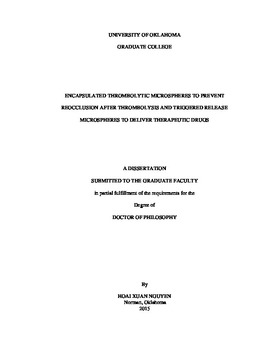| dc.description.abstract | Cardiovascular diseases, including acute myocardial infarction, stroke, peripheral arterial diseases, and pulmonary embolism, are the most common and growing cause of morbidity and mortality in the United States. Early reperfusion of occluded blood vessels can be achieved by using thrombolytic therapy. However, thrombolysis is associated with its side effects, including bleeding complications and reocclusion. The hours after treatment for myocardial infarction represent a critical period when the patient is subject to reocclusion and a second coronary event. While rapid release on the order of minutes is desirable initially, an extended half-life of a thrombolytic agent functions better to address reocclusion.
The overall goal of this research was the design, synthesis, characterization and testing of microspheres which i) are suitable for extension the half-life of a thrombolytic agent for prevention of reocclusion in vitro, and ii) provide a general controlled release by triggered release mechanism for cardiovascular delivery of therapeutic drugs.
The first project of this thesis is to synthesize dextran acetate (DA) with various degrees of substitutions (DA1<DA2<DA3) and prepare, characterize polyethylene glycol (PEG)/DA microspheres which were combined with PEG microspheres to provide short and intermediate term release. Bovine serum albumin (BSA) was used as a model protein. PEG/DA3 microspheres exhibited the release of BSA on the scale of hours (180 min), more slowly than that of PEG microspheres. The percentage of BSA released from PEG and PEG/DA3 microspheres with time (min) was modeled mathematically [YPEG = 100(1 – e−0.12t); YPEG/DA3 = 100(1 – e−0.024t)] in order to predict cumulative delivery from mixtures in vitro over a period of hours when constrained to a target level at 30 min. The system is examined for potential application in thrombolytic therapy.
The second project is to develop and characterize eudragit (Eud) microspheres which were coated with chitosan (CS) by the covalent bonding in order to meet short and longer term needs. The extension of thrombolytic activity of these microspheres in in vitro experiments was also examined. CS-Eud/SK microspheres had a lower encapsulation efficiency of streptokinase (SK), reduced activity of SK, and a much slower release of SK when compared with those of Eud/SK microspheres. Release of SK from Eud/SK microspheres obeyed first-order kinetics model [YEud/SK = 100(1 – e−0.6t)] while release of SK from CS-Eud/SK microspheres obeyed the Hixson-Crowell model [YCS-Eud/SK = 100(1 – (1 – 0.1t)3)]. Counter-intuitively, slower release leads to faster thrombolysis as a result of greater penetration of agent into the thrombus and the mechanism of distributed intraclot thrombolysis. In the in vitro lysis experiment, the presence of CS coating on the surface of Eud/SK microspheres induced a much slower release of SK up to 8 h which would seem to provide clot-lytic efficacy in prevention of second blockage up to 4 h. This study has demonstrated that longer release times leading to extended half-life in plasma can be expected to offer prevention of reocclusion.
The third project is to synthesize and characterize a novel amine-modified acetalated dextran polymer which is combined with heparin to develop triggered release microspheres for the delivery of therapeutic agents. In this study, we extend the underlying concept of Yang's ATTEMPTS (antibody targeted, [protamine] triggered, electrically modified prodrug-type strategy) system to enable controlled release from microspheres. By encapsulating a drug in a cationic dextran-heparin microsphere, we broaden the protamine initiated release mechanism so that delivery can be generalized to a greater range of agents. In particular, a drug need not be electrically modified with this approach. | en_US |
